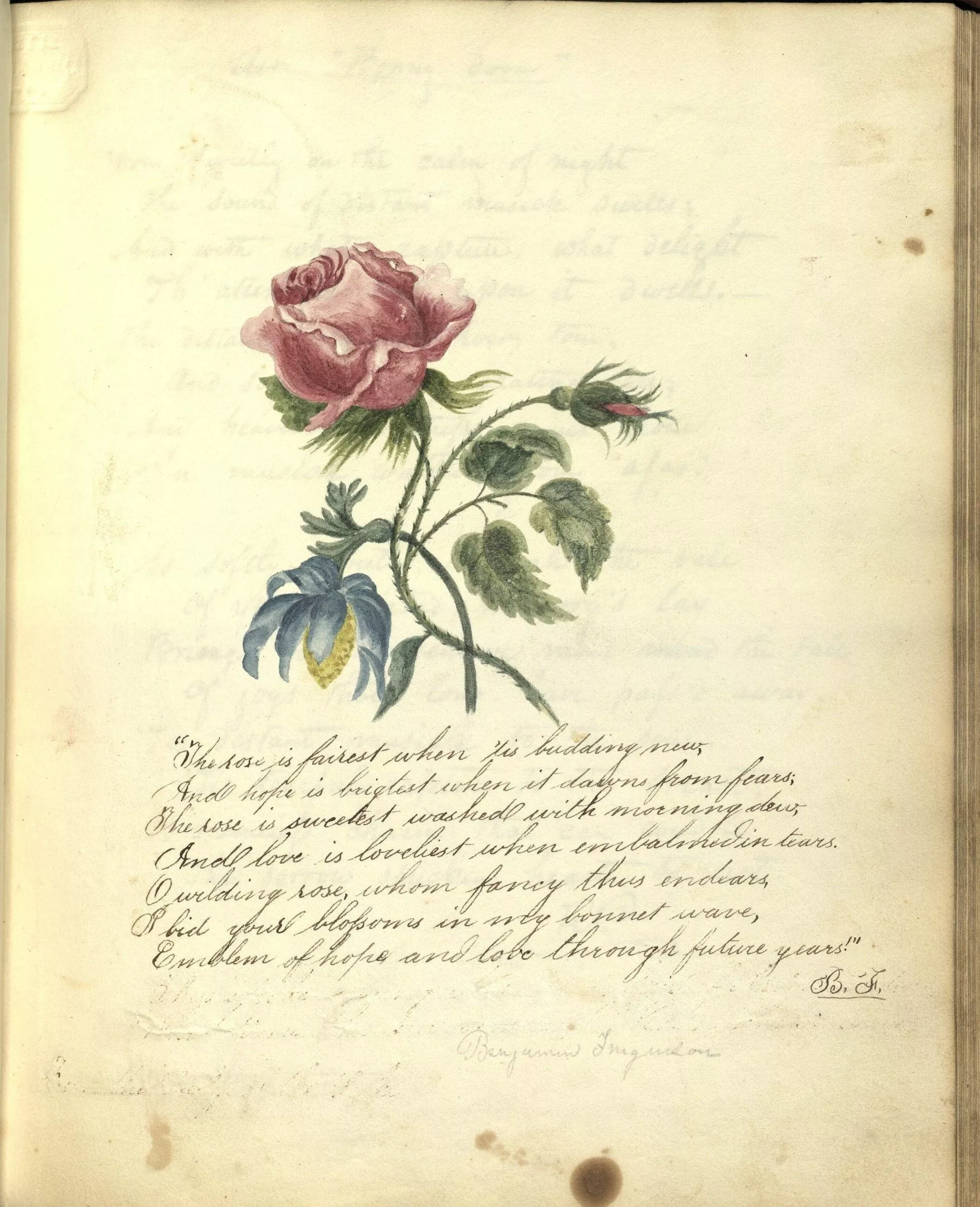Creation Date
1826-1842?
Height
23 cm
Width
19 cm
Medium
Genre
Description
At the center of this page an unknown artist has painted in watercolor two pink roses growing from a single stem--one almost in full bloom, the other just beginning to bud—and entwined it with a blue and yellow bloom (perhaps a passion flower). Beneath this bouquet, an excerpt of seven lines from the opening of Canto 4 of Sir Walter Scott’s 1810 The Lady of the Lake has been written out in black ink. Though placed inside quotation marks, the lines are not attributed to Scott anywhere on the page: the signature “B.F.” follows them, likely identifying the transcriber who selected these lines for Mrs. Sarah Schenck’s album (“Benjamin Furguson” has been written in pencil further down the page, likely by a librarian or archivist). The handwritten lines read:
The rose is fairest when ‘tis budding new,
And hope is brightest when it dawns from fears,
The rose is sweetest washed with morning dew,
And love is loveliest when embalmed in tears.
O wilding rose, whom fancy thus endears,
I bid your blossoms in my bonnet wave,
Emblem of hope and love through future years!
Close scrutiny of the page reveals that the transcriber once intended to include, but later erased, the final two lines that would have completed the ababbcbcc rhyme scheme of Scott’s Spenserian stanza. One can almost make out from the faint pencil marks left behind the pair of lines that in Scott’s original text identified this address to the rose as a speech made by one of the narrative poem’s minor characters: “Thus spoke young Norman, heir of Armandave,/ What time the sun arose on Vennachar’s broad wave.”
The seven lines forming Norman’s address to the rose that B. F. did decide to leave on the page were frequently excerpted from The Lady of the Lake. In their original context, the lines are spoken by a character whose wedding has been interrupted by the warfare and clan rebellion that are the main events of Scott’s poem, which he set in the Scottish Highlands during the reign of King James V. In fact, in the very next stanza Norman will lay down his spray of wild rose and, readying himself for battle, pick up his axe and bow. When removed from the narrative and transplanted into the context of the album, annual, or poetic miscellany, these seven lines become, by contrast, a compliment paid to youth as youth—the perfect poetical offering to make to a blooming girl and the perfect poetical accompaniment to the flower painting that was so frequent an avocation among young women. (The erasures on this page might suggest that B. F. was more inclined to be faithful to Scott’s text than to conform to the language of flowers conventional to the album.) It is telling that by the year of Scott’s death “The rose is fairest when ’tis budding new” had become the motto that formed the banner of the juvenile newspaper, The Rose Bud, or Youth’s Gazette, edited in Charleston, South Carolina, by Caroline Howard Gilman.
Sarah Schenck’s album, inexpensively bound in maroon cloth, was compiled between 1826 and 1842. It contains other examples of flower painting, including, some pages on from this one, another watercolor of a blooming rose that likewise appears to have been copied from a how-to manual for aspiring watercolorists. At one time, a label still found on one page indicates, it also included art-work by Martha Honeywell: perhaps the disabled artist by that name (1786-1856), who was celebrated in North America for her cut-paper and silhouette work. The album includes, as well, two more handwritten transcriptions of other selections from Scott’s poetry, as well as some original verse sometimes addressed to and sometimes signed by “Sarah.”
Associated Works
Collection
Accession Number
MS Am 889.283
Additional Information
Post-publication marks: Possibly curatorial/archivist/librarian’s note: Penciled note identifying the signature B. F.
Place of creation: Likely New York, New York .

